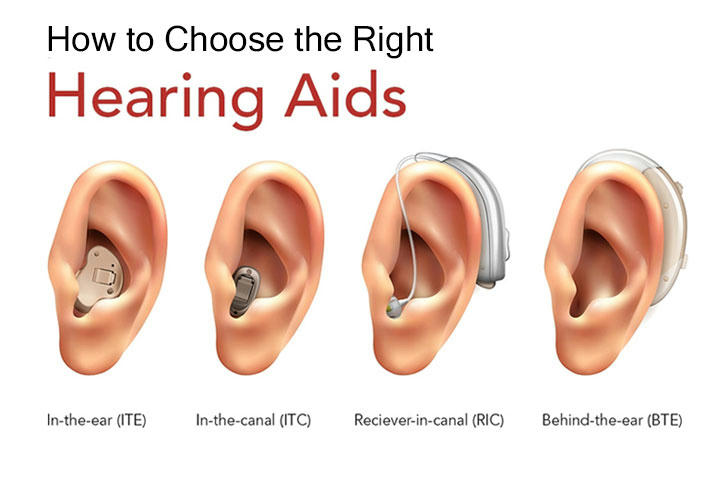How to Choose the Right Hearing Aid?
Have you been missing parts of conversations? Struggling to hear the TV even when the volume is maxed out? You’re not alone. Nearly one in three seniors in the U.S. experience some degree of hearing loss, and finding the right hearing aid can be life-changing.
The problem? There are hundreds of options—from tiny, nearly invisible models to powerful behind-the-ear devices. How do you know which one is best for you? Let’s get started!

1. Completely-in-Canal (CIC) Hearing Aids: Best for Mild Hearing Loss
If you don’t want people to know you’re wearing a hearing aid, a Completely-in-Canal (CIC) hearing aid is your best choice. These tiny devices fit deep inside the ear canal, making them nearly invisible.
Who It’s Best For:
✔ Seniors with mild to moderate hearing loss
✔ Those who want a discreet, nearly invisible option
✔ People who mostly stay indoors and don’t need advanced features
Pros:
✅ Small & discreet—No one will even know you’re wearing it
✅ Natural sound quality since it sits deep in the ear canal
✅ No interference from wind noise
Cons:
❌ Not powerful enough for severe hearing loss
❌ Small size can make it hard to handle if you have arthritis
❌ Short battery life due to the compact design
🔊 Product Mention: The EARGO 6 CIC Hearing Aid is a popular choice for its comfortable fit and rechargeable design.
2. In-the-Ear (ITE) Hearing Aids: Best for Easy Handling
For those who want a balance between power and convenience, In-the-Ear (ITE) hearing aids are a great choice. They sit inside the outer ear, making them larger than CIC models but still smaller than behind-the-ear devices.
Who It’s Best For:
✔ Seniors with mild to moderate hearing loss
✔ People who have trouble handling tiny hearing aids
✔ Those who want easier volume and setting adjustments
Pros:
✅ Larger buttons—easier for seniors with dexterity issues
✅ More powerful than CIC models
✅ Custom-fit for better comfort
Cons:
❌ Still visible—not as discreet as CIC hearing aids
❌ Can pick up wind noise since it sits outside the ear canal
🔊 Product Mention: The MDHearingAid VOLT+ ITE Hearing Aid is a top-rated rechargeable model that offers excellent sound clarity.
3. Behind-the-Ear (BTE) Hearing Aids: Best for Severe Hearing Loss
If you have moderate to severe hearing loss, a Behind-the-Ear (BTE) hearing aid is the most powerful option. These devices rest behind the ear and connect to a custom earpiece inside the ear canal.
Who It’s Best For:
✔ Seniors with moderate to severe hearing loss
✔ Those who need the most amplification
✔ People who prioritize performance over size
Pros:
✅ Most powerful hearing aid type—great for severe hearing loss
✅ Rechargeable battery options available
✅ Durable and long-lasting
Cons:
❌ Larger and more noticeable than other types
❌ May pick up background noise if not properly adjusted
🔊 Product Mention: The Oticon More BTE Hearing Aid is a popular choice for its AI-powered noise reduction and clear speech processing.
4. Rechargeable Hearing Aids: Best for Convenience
Tired of changing tiny batteries every week? Rechargeable hearing aids are a game-changer, offering long battery life and quick charging.
Who It’s Best For:
✔ Seniors who don’t want to deal with small batteries
✔ People who use their hearing aids all day
✔ Those who want a cost-effective, eco-friendly solution
Pros:
✅ No battery replacements—just charge overnight
✅ Better for the environment
✅ More cost-effective in the long run
Cons:
❌ Requires daily charging
❌ Limited options compared to traditional models
🔊 Product Mention: The Phonak Audeo Lumity Rechargeable Hearing Aid is a top-tier option with crystal-clear sound quality and Bluetooth connectivity.
5. Over-the-Counter (OTC) Hearing Aids: Best for Budget Buyers
For those who don’t want to go through a doctor or insurance approval, Over-the-Counter (OTC) hearing aids are a new, affordable option. These devices are self-fitting and available without a prescription.
Who It’s Best For:
✔ Seniors with mild hearing loss
✔ Budget-conscious buyers
✔ Those who want a quick, no-hassle solution
Pros:
✅ Affordable compared to prescription hearing aids
✅ Available without a hearing test
✅ Easy to buy and use
Cons:
❌ Not suitable for severe hearing loss
❌ Limited customization compared to prescription models
🔊 Product Mention: The Sony CRE-C10 OTC Hearing Aid is one of the best OTC options, offering good amplification and noise reduction.
Does Medicare or Insurance Cover Hearing Aids?
🟢 Medicare Advantage (Part C) may cover hearing aids depending on the plan.
🟢 Private insurance companies sometimes offer partial coverage.
🟢 Medicaid in some states covers hearing aids for low-income seniors.
🟢 Veterans may qualify for discounted hearing aids through the VA.
💡 Tip: Check with your insurance provider to see if you qualify for discounts or reimbursement.
Conclusion: Choose the Right Hearing Aid for You
The right hearing aid can change your life, bringing back the sounds you love and keeping you connected with family and friends. Whether you need a tiny, invisible device or a powerful, feature-rich model, there’s an option that fits your needs and budget.
🚀 Ready to improve your hearing? Check out the recommended Amazon hearing aids above and take the first step toward better hearing today!
